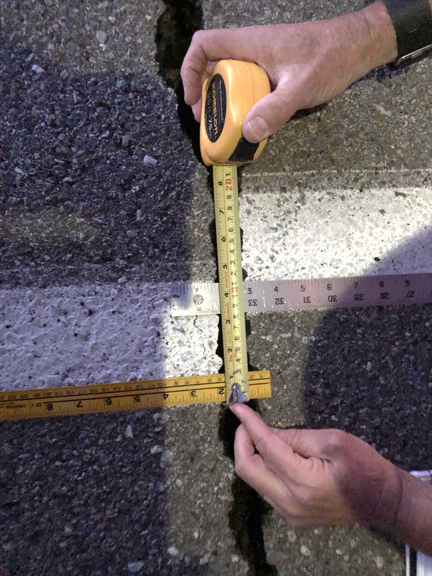Despite epicenters that were miles away, the Crescenta Valley was not immune to the shaking caused by the Ridgecrest earthquakes.

A scientist measures a fault offset on California State Route 178. This measurement was conducted following the Magnitude 6.4 earthquake that struck Searles Valley on July 4, 2019.
By Charly SHELTON
At 10:33 a.m. on July 4, a magnitude 6.4 earthquake struck just outside of Ridgecrest, California, in the China Lake area of the Mojave Desert. The next morning, a M 5.4 aftershock hit. Then that evening, a M 7.1 quake hit the same area. This sent shockwaves across the state, heading into Nevada and down to Mexico. The largest quakes to hit the area in more than 20 years, these were a wakeup call for the residents of earthquake country and a reminder that earthquakes are a constant threat though it has been a while since the last big quake hit the Southland.
“Over the July 4 weekend, California experienced its two strongest earthquakes in 20 years,” Congressman Adam Schiff said in a statement. “We were fortunate that there were no serious injuries and damage was limited, but it’s a reminder that it’s not a question of whether a major earthquakes will strike, but when. We have to do everything we can to ensure we are prepared.”
The quakes hit on a collection of intertwined faults called the Little Leg system just to the northwest of Ridgecrest, about 120 miles northwest of LA. The series of quakes that were felt over July 4 and July 5 were the product of a new fault being born.
“The epicenter of the 7.1 is at the northwest end of the fault that moved in the 6.4 [quake]. Now the 5.4 aftershock extended it a bit to the northwest and the 7.1 seems to have extended it even further to the northwest. So the fault is growing,” said Dr. Lucy Jones, U.S. Geological Survey & Caltech seismologist, in a press conference immediately after the M 7.1 quake. “We ruptured a piece in the first earthquake, we ruptured a bit more in the 5.4 and we’re rupturing more now [with the 7.1]. It’s moving towards the northwest, away from the metropolitan area, as far as we can tell.”
In the fault systems around that area, earthquake sequences are common. In 1872, Owens Valley was hit with a M 7.5 followed by several M 6 aftershocks. In 1915, Nevada’s Pleasant Valley quake was a M 6.8 followed by a sequence of strong aftershocks. Again, in 1954, Nevada was rocked with a sequence of quakes topping out with a M 7.2 and M 6.8, which occurred within four minutes of each other out of the Fallon-Stillwater area. In 1980, Mammoth felt a M 6.0 quake, followed 16 minutes later by a M 5.5, and then 72 magnitude 4.0 – 4.9 events, six magnitude 5.0 – 5.5 events and three events of magnitude 6.0 – 6.3 during the next 48 hours.
But the area is not immune to large, one-off quakes either, like the M 7.5 quake out of Owens Valley in 1872. So this sequence of earthquakes – one after another as was seen over the weekend – is commonplace for seismic activity in the area.
“This part of California is characterized by these types of groups of earthquakes; there might be several that end up larger, the first one is often not the biggest one,” Jones said. “Knowing which one is the biggest means waiting until we see that we aren’t getting another one.”
Initially, the first large quake – the M 6.4 – was the main shock. But when an aftershock larger than the main shock occurs, the names are changed. The M 7.1 is now the main shock and the M 6.4 and M 5.4 are now foreshocks. If another quake in this same sequence hits that is larger than the M 7.1 from July 5, the labels will be changed again. Once the sequence is officially over, the aftershocks can still come for years.
“The 7.3 Landers Quake [out of the Palm Springs area in 1992], the last M 5 [aftershock] to that happened in 1998, six years after the main shock. So we should be expecting to record earthquakes [in Ridgecrest] for a long time,” Jones said.
The ShakeAlert system has recently come under fire for not alerting app users of the impending shaker. The new system, which is still being put in place, is designed to detect earthquakes as soon as they happen and then alert registered users of the imminent shaking. Through the ShakeAlertLA app, users should have had a push notification if the shaking would be above M 5.0. With these M 6.4 and M 7.1 quakes, many users expected an alert that never came. However, the system didn’t malfunction; everything worked as it should have – the shaking just wasn’t strong enough in LA to activate it.
“ShakeAlertLA received a notification from the [U.S. Geological Survey] sensor network that the shaking was below the threshold set by the City and USGS for notification in the LA county area during the July 4 and 5 earthquakes,” said Andrea Garcia, press secretary with Mayor Eric Garcetti’s office. “Therefore, the ShakeAlertLA app did not issue an alert to users. The City of Los Angeles has been working with USGS to lower the threshold for users to receive alerts, and the updates will be implemented this month.”
The M 6.4 quake only registered below a M 4.5 shaking felt in LA, according to a tweet from City of LA. The app’s threshold for notification is if the shaking in LA County is above M 5.0, and that wasn’t reached by the recent quakes. USGS, which oversees the ShakeAlert system, has been alerted to this and the threshold will be lowered to alert on any M 4.0 and higher shaking, starting at the end of July.
